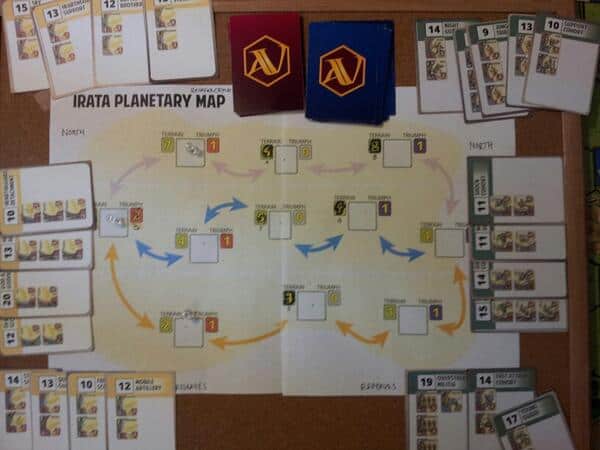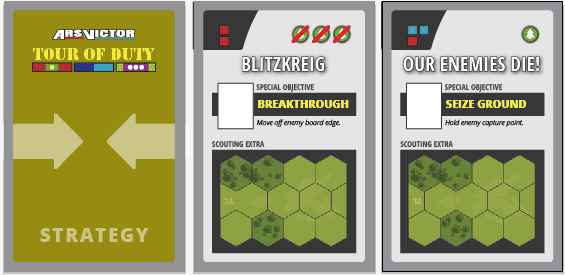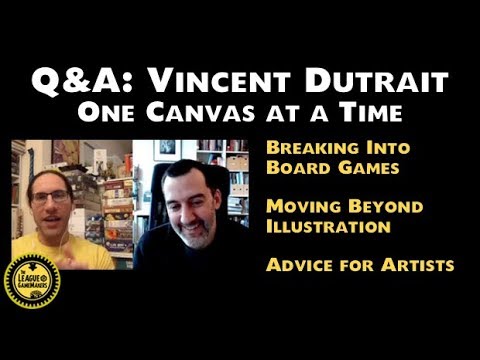
I’m still constantly amazed at how much designs can be improved by removing things, rather than adding things. I’ve had another lesson in minimalism during my design of Ars Victor: Tour of Duty.
WHAT IS ARS VICTOR: TOUR OF DUTY?
From the beginning, I’ve had a number of expansions planned for Ars Victor. One of those ideas is Ars Victor: Tour of Duty. Because a single game of Ars Victor can be played in less than an hour, the notion was to create a ‘campaign game’ expansion that let multiple people play multiple interrelated games.
The focus of this expansion was not to add additional content to the battlefield, but to create a context within which Ars Victor could be played. It’s sort of the tabletop equivalent to the “Total War” series of computer games: you have a strategic game where you’re mustering your armies, and a tactical game where you slug it out in the mud.

My initial pass at the design involved a deck of cards and a map. The idea was that two sides would fight back and forth over a contested front, and eventually triumph by taking the enemy capital. The cards represented fixed allocations of units that got distributed amongst multiple players on the same team. The location of the battle on the strategic map influenced the board setup towards terrain-heavy or terrain-light.
FIRST TESTS: COULD BE BETTER
This worked fairly well in playtest, but a few things jumped out at me:
- It didn’t scale with the number of players. Yes, you could technically play a 2-player game of this, and just have the same two players fight each battle on each front. But it was really designed for a six-player (two teams of three) matchup.
- The strategic game wasn’t that interesting. There wasn’t any real decision-making to be done by the overall team commander. And the progression of capturing spaces and pushing towards the enemy capital wasn’t really engaging.
- Having a fixed army build and restrictions on map building was really fun! That may seem strange — how can having fewer choices be more fun?

Ars Victor has a huge amount of player choice in game setup. Unlike other games of its ilk, it doesn’t limit you to fixed-army scenarios (Command & Colors, Memoir 44), or fixed map setups (Battlelore). It gives you vastly more options in army builds, map setups, and overall strategy. It’s similar to Warhammer 40k in that sense — you have complete control over your army composition, which then dictates how you set up the map, and how you play.
As you get more experienced, you start to learn what are “good” army builds and what are “bad” army builds. Regardless of your overall strategy, there are certain laws that almost always hold true: having skirmish units is important, you need units that can throw blue dice, your HQ should be survivable and mobile, etc. You can see what players are building and what they’re talking about at our on-line Army Builder.

REDUCING CHOICES
The initial tests of Ars Victor: Tour of Duty showed that being forced to play “bad” builds was actually fun! The best battles in the Tour of Duty games were the ones where both players were stuck with sub-optimal forces in less-than-ideal conditions. Both players were forced to improvise strategically and tactically. You saw matchups that you would never see in a “normal” game. In short, it was a hoot.
So I started to explore that more, and realized what I really needed to build was a random scenario generator. The fun comes from the interactive choices in building the scenario, and then playing a game of Ars Victor that you’d never normally choose to play. That’s context.
NEW DESIGN
The new version of Tour of Duty is far simpler, and far more interesting. In it’s simplest form, two players are just pulling cards from three different decks and using some of them to dictate battle setup. Each deck is used in a certain way, and each deck affects game setup and scoring in a different way:
OBJECTIVE CARDS

Objective Cards are dealt out face-up, one per battle. They set the stage for the scenario in a few minor ways:
- Starting Glory. In Ars Victor, your Glory is basically your “army hit points” that you spend on units. Normal games give each player 80 Glory.
- Strategic Value. Tour of Duty has a parallel concept called War Will. Each team starts with a certain amount of War Will. When a team loses a battle. it loses the Strategic Value of that battle in War Will.
- Terrain Density. This determines how terrain-heavy a battlefield is. In Ars Victor, both players build the map by placing map tiles in the Scouting phase. Each map tile has one side with lots of terrain and the other with less. Terrain Density forces players to use that many of the terrain-heavy side of map tiles during scouting.
STRATEGY CARDS

A limited number of these are drawn by a team’s overall commander, who plays them face-up on a battlefield when they assign a player to that battlefield. They are specific to one side, and they alter the game setup and introduce Special Objectives.
- Initiative Dice. In a normal game, you have a 50/50 chance of winning Initiative and choosing to attack or defend. With Tour of Duty, each player will roll the dice specified on their Strategy card, and the one with the most skulls wins the Initiative.
- Terrain Density Modifier. This alters the Terrain Density given by the Objective Card.
- Special Objective. This gives a player an extra way to score against their enemy. I’ve created four special scoring rules: Breakthrough, Seize Ground, Hold the Line, and Assassinate.
- Scouting Extras. If you own the Fields of Blood expansion, this lets you place a specific map tile from that expansion.
REGIMENT CARDS

A number of these are drawn by the team commander, who hands them out secretly when they assign a player to a battlefield. The cards stay with that player until any of the units that they provide fall in battle. The commander then gets to draw replacement cards and hand them out for the next battles.
Each Regiment Card specifies the units that must be used by the player in the upcoming battle. They don’t have to use all their Regiment Cards, but they have to use all the units from every card that they play.
OTHER CHANGES
The map is gone. Instead you have a War Will for each team; the starting value can vary based on how many players and how long of a campaign you want. It’s completely flexible as to how many players you have involved, Because War Will is the only thing you really have to track, it would even work as an extended event, with multiple games played by dozens of players over the course of weeks.
CONCLUSIONS
The new version is much cleaner, and exemplifies the “less is more” notion in a couple of ways:
- By abandoning the strategic map, I’ve reduced unnecessary tracking and pointless decision making, and allowed for more interesting decisions on how scenarios are built.
- The new rules and decks reduce the players’ choices during game setup, resulting in more interesting and unorthodox match-ups.
And once again, I am reminded of this quote:
PERFECTION IS ACHIEVED, NOT WHEN THERE IS NOTHING MORE TO ADD, BUT WHEN THERE IS NOTHING LEFT TO TAKE AWAY.
– ANTOINE DE SAINT-EXUPERY
THOUGHTS?
Have you found that removing or streamlining things in your designs has made them better? Are there titles out there that you think would be better off if they had less? (I’m looking at you, Battlestar Galactica)








